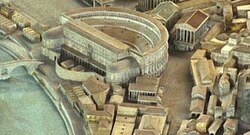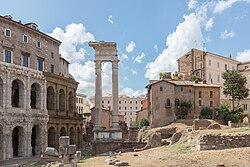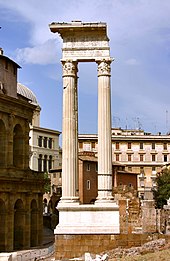Tempio di Apollo Sosiano
( Temple of Apollo Sosianus )The Temple of Apollo Sosianus (previously known as the Apollinar and the temple of Apollo Medicus) is a Roman temple dedicated to Apollo in the Campus Martius, next to the Theatre of Marcellus and the Porticus Octaviae, in Rome, Italy. Its present name derives from that of its final rebuilder, Gaius Sosius.
The three columns of the temple which survive to full-height today belong to the Augustan rebuild, but the cult of Apollo had existed in this area since at least to the mid-5th century BC when an Apollinar (a sacred grove or altar) was recorded on this site. Since Apollo was a foreign cult, it thus legally had to be placed outside the pomerium,[1] making it a regular spot for extra-pomerial senate meetings.[2] (This was also Apollo's only temple in Rome until Augustus dedicated another on the Palatine Hill.)[3]
The first temple building dates to 431 BC, when the consul Gaius Iulius Mento inaugurated one dedicated to Apollo Medicus (the doctor), in fulfilment of a vow to him during a plague of 433 BC.[4] This building was restored in 353 BC,[5] and perhaps in 179 BC, when the censor Marcus Aemilius Lepidus and his colleague let the contract for building a porticus from the temple to the Tiber, behind the temple of Spes.[6] The censor's projects also included a nearby theatre. The shedding of tears for three days by a cult-statue of Apollo, cited among the prodigies at the death of the Younger Scipio,[7] can only have occurred at this temple, there being no others to Apollo.
A neighbouring temple dedicated to Apollo's sister Diana probably dates to the late Republic, following the destruction of the Apollo temple's precinct in work on the theatre of Marcellus.
Sosian reconstruction The Theater of Marcellus, the Forum Olitorium, and the temples of Bellona and Apollo, from Gismondi's c. 1:250 scale model of imperial Rome at the Museum of Roman Civilization
The Theater of Marcellus, the Forum Olitorium, and the temples of Bellona and Apollo, from Gismondi's c. 1:250 scale model of imperial Rome at the Museum of Roman CivilizationA radical reconstruction was begun by Gaius Sosius, probably just after his triumph in 34 BC.[8] These building-works were themselves soon interrupted by the civil war between Octavian and Antony (with Sosius taking Antony's side), and only resumed some years later when Augustus was reconciled with Sosius. It was thus dedicated in the end to the name of the princeps, with the dedication day in the Augustan period of 23 September.[9] Upon the construction of the theatre of Marcellus soon afterwards the temple's frontal staircase was demolished and replaced with two staircases on the sides of the "pronaos".
Late RomanOnly minor reconstructions are known after the Augustan phases, by the urban prefect Memmius Vitrasius Orfitus (356 - 359) and perhaps by Anicius Acilius Fortunatus Glabrio in the 420s. The temple would have been closed during the persecution of pagans in the late Roman Empire, when the Christian Emperors issued edicts prohibiting all non-Christian worship and sanctuaries.
Medieval and modern The Temple, with the Theatre of Marcellus on the left and Porticus Octavia at the backside
The Temple, with the Theatre of Marcellus on the left and Porticus Octavia at the backside The three re-erected columns
The three re-erected columnsThe temple's ruins were occupied in the post-Roman period by medieval dwellings right up to the 1930s, when these were demolished between 1926 and 1932 to allow the theatre of Marcellus to be seen in isolation. In those same works the remains of the fallen colonnade were recovered in the very positions in which they had fallen, inside the arches of the theatre and as a result in 1937 and 1938 the podium's remains were excavated. In 1940 the fallen columns were raised on this podium, though probably not in their original positions.
Additional WorksTwice, Pliny[10] speaks of works of art in this temple, probably referring to loot brought back from Greece by Sosius and placed within his reconstruction of the temple. These include:
paintings by Aristides of Thebes[11] several statues by Philiscus of Rhodes[12] an Apollo Citharoedus by Timarchides[13] a statue of Apollo in cedar wood from Seleucia[14] the celebrated group of the Niobids[15] (attributed by the ancients to Scopas or Praxiteles, now attributed to neither).[16]





























Add new comment